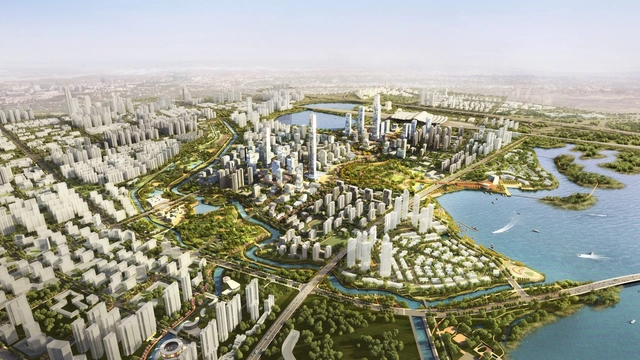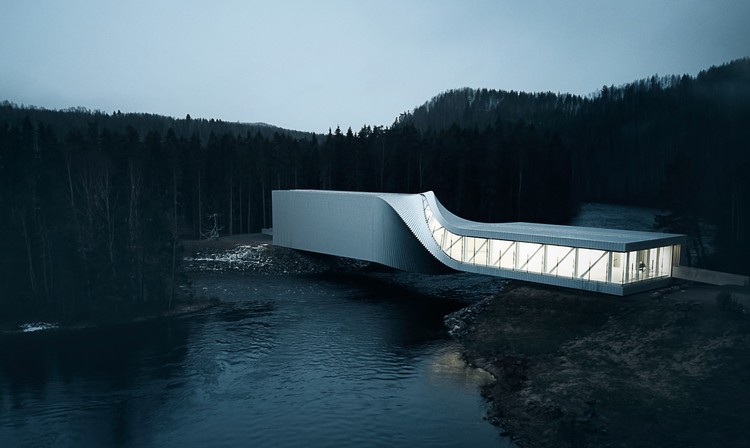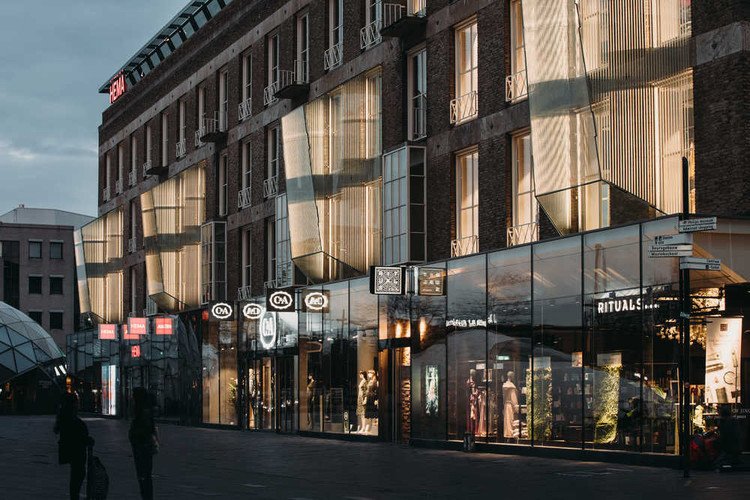Produce personalized presentation boards that distill complex concepts into simple visual representations with a few helpful tools and effects.
Architecture News
How to Create Architectural Presentation Boards
AIA’s COVID-19 Task Force Creates Design Guide to Retrofit Buildings for Alternative Care

As hospitals in the United States are starting to hit capacity due to the COVID-19 pandemic, the American Institute of Architects has released a new design guide from their COVID-19 Task Force. The “Preparedness Assessment Tool” is intended to assist non-healthcare design professionals with identifying alternate sites suitable for patient care. The task force developed the tool using established healthcare design best practices and standards in combination with federal documents issued during the crisis.
Latest Images Reveal Near Completed MVRDV's Art Depot for Museum Boijmans Van Beuningen

The public art depot for the Museum Boijmans van Beuningen, designed by MVRDV is nearing completion in Rotterdam. Scheduled for opening in September 2021, recent images showcase the installation of the first of 75 trees on the roof garden.
Fairy Tales Competition Announces 2020 Winners

Blank Space, the online platform has announced the winners of its annual ‘Fairy Tales’ competition. The seventh edition of the contest selected top entries that offer tales of warning and hope during uncertain times.
WEISS/MANFREDI Receives 2020 Thomas Jefferson Foundation Medal in Architecture

Design practice WEISS/MANFREDI has won the 2020 Thomas Jefferson Foundation Medal in Architecture. Presented by the University of Virginia and the Thomas Jefferson Foundation at Monticello, the award is one of four honors recognizing achievements in architecture, citizen leaderships, global innovation, and law. The Thomas Jefferson Foundation Medals recognize the exemplary contributions of recipients to the endeavors in which Jefferson excelled and held in high regard.
The American-Inspired Russian Architecture

From the famous Kitchen Debate between Nikita Khrushchev and Richard Nixon to the popularity of Henry Ford within the USSR, the hundreds of factories designed by Detroit engineer Albert Kahn for Soviet Russia, and skyscrapers erected in Moscow, the Cold War had a peculiar side to it, that is the Russian fascination with American culture and technology.
Brickell Flatiron, Miami’s Tallest All-Residential Tower, Is Now Completed
_Golden_Dusk_Photography.jpg?1586260356&format=webp&width=640&height=580)
Miami’s tallest luxury condominium, the recently completed Brickell Flatiron tower is designed by architect Luis Revuelta, with interiors created by Italian design architect Massimo Iosa Ghini. Standing tall at 736-feet-high, the residential building is the newest icon of Brickell's Financial District
Harvard GSD Announces Series of Online Public Events for April
.jpg?1586335550&format=webp&width=640&height=580)
Harvard GSD is presenting during the month of April 2020, an online series of talks and webinars via Zoom, where attendees can interact and submit questions. Accessible for everyone who registers, the events are also streamed live to the GSD's YouTube page.
BIG's Twist Museum Photographed Through the Lens of Jacob Due

The new Twist Museum by Bjarke Ingels Group is open in Norway. Traversing the winding Randselva river, the inhabitable bridge is torqued at its center, forming a new journey and art piece within the Kistefos Sculpture Park in Jevnaker. The project was recently captured through a series of images by photographer Jacob Due. The photos explore the museum's formal approach and place the design in its larger natural context.
Spotlight: Richard Neutra

Though Modernism is sometimes criticized for imposing universal rules on different people and areas, it was Richard J. Neutra's (April 8, 1892 – April 16, 1970) intense client focus that won him acclaim. His personalized and flexible version of modernism created a series of private homes that were—and still are—highly sought after, making him one of the United States' most significant mid-century modernists. His architecture of simple geometry and airy steel and glass became the subject of the iconic photographs of Julius Schulman, and came to stand for an entire era of American design.
Marc Thorpe Proposes Houses for the Workers of Moroso on the Outskirts of Dakar Senegal

Marc Thorpe, New York-based architect and multidisciplinary studio, has designed the Dakar Houses for the workers of Moroso M’Afrique furniture collection. Located on the outskirts of the Senegalese capital in West Africa, the prototype houses are made from earth bricks.
Sasaki Completes Master Plan for New Urban District next to Wuhan's High-Speed Rail

Designed by Sasaki in collaboration with an interdisciplinary team including Arup, JLL, and the Wuhan Planning Institute, the Wuhan Yangchun Lake Business District master plan was approved by the city. Imagining “a progressive yet realistic vision for the district”, the project, a landscape-forward urban blueprint, will define Wuhan’s next generation of growth.
Harvard GSD Announces 2020 Wheelwright Prize Finalists

Harvard Graduate School of Design (Harvard GSD) has announced three shortlisted architects for the 2020 Wheelwright Prize. Now in its eighth cycle, the Wheelwright Prize supports innovative design research, crossing both cultural and architectural boundaries, with a $100,000 grant intended to support two years of study. The 2020 Wheelwright Prize drew 168 applicants from over 45 countries.
Höweler + Yoon and Sasaki Announce New Residential Tower in Boston

Höweler + Yoon Architecture and Sasaki have announced the groundbreaking for new construction on 212 Stuart Street, in the historic Bay Village neighborhood in downtown Boston. The residential tower is a 19-story building containing 126 units with two townhouses and retail space on the ground level.
CHYBIK + KRISTOF to Bring Gregor Mendel's Historic Greenhouse to Life
.jpg?1585861631&format=webp&width=640&height=580)
On the 200th anniversary of Gregor Mendel’s birth, CHYBIK + KRISTOF will bring the historic St. Augustin Abbey greenhouse to life in Brno. As the location where the notorious scientist and father of modern genetics conducted his pioneering experiments, the greenhouse is located in the 14th-century Augustinian monastery’s gardens. After the original building was swept away by a storm in the 1870s, the team aims to return the significant site to Brno’s old city in 2022.
Share Your Work From Home Experience and Join the Remote Architects Club

With the COVID-19 pandemic forcing many architecture firms to quickly transition into a work from home, designers are having to discover new ways to work without everyone being in the same room. The casual conversations, overheard ideas, and site visits that were once an integral part of our jobs have been put on pause, and have left some architects wondering how everyone else is continuing project work.
Shift Architecture Urbanism Creates Hyperlocal Micro Markets that Operate During COVID-19 Shutdowns

Shift architecture urbanism developed micro-markets that can operate on a hyper-local scale during coronavirus shutdowns. The research elaborated on a scheme allowing traders to provide fresh food in a safe way to the self-quarantined inhabitants of the city.
Drawing Matter Launches 2020 Writing Prize

The Drawing Matter Trust has announced a new Drawing Matter Writing Prize for 2020. Over the next few months, Drawing Matter will be focused on encouraging writing about drawings for both architecture and design. The competition invites writers to consider what drawings reveal about the process of design, and the buildings or objects they represent. The hope is to make the prize an annual event.
UNStudio Rethinks Traditional Glazing in Two Adaptive Reuse Designs

UNStudio completed two remodel projects in the Netherlands rethinking traditional glazing techniques. Located in Eindhoven and on the P.C Hooftstraat in Amsterdam, the projects each draw from their context and take inspiration from local history and culture. Made to restore and connect the two existing structures to their respective cityscapes, the projects are designed to restore the urban fabric as they connect to passerby.
Ravi Naidoo from Design Indaba Elaborates on the Purpose of Design in reSite Podcast

Design and the City is a podcast by reSITE, raising questions and proposing solutions for the city of the future. In the final episode, Ravi Naidoo from Design Indaba discusses the purpose of design. Aiming to define the field, the founder of Interactive Africa, a company based in Cape Town, and the design platform Design Indaba shares his personal thoughts on empowering people to create a better future through creativity.
Adapting Existing Spaces: New York City’s Response to the COVID-19 Pandemic

As New York is facing unprecedented circumstances and as the numbers of infected people with the coronavirus are reaching new highs, officials are seeking fast and efficient solutions to generate useful spaces for patients. With a timeline of a few weeks, the city is looking into ways of altering the existing structures.
World Architecture Festival Still Planned for December and Gives Additional Time to Submit your Entries
.jpg?1585746886&format=webp&width=640&height=580)
World Architecture Festival and World Festival of Interiors: Inside is scheduled for 2 – 4 December, in Lisbon. Preparations for the event are going ahead in the typical way and architects from across the globe are continuing to submit their online awards entries.
American Architect Michael McKinnell Dies from Coronavirus Complications

Michael McKinnell, a British-born American architect, known for his work on the acclaimed Boston’s Brutalist City Hall, and co-founder of the Kallmann McKinnell & Wood architectural design firm, has passed away on March 27, 2020, at the age of 84, from COVID-19-induced pneumonia.
GWP Creates Fengsheng 101 Tower, a New Landmark in Guangzhou's Skyline

GWP Architects imagined a mixed-use development tower, reaching a height of 200 meters with a total construction area of approximately 81,000 square meters. Located in Guangzhou, the project entitled Fengsheng 101, includes hotels, offices, apartments, and commercial stores.


















_Golden_Dusk_Photography.jpg?1586259969)
_Golden_Dusk_Photography.jpg?1586260024)
_Golden_Dusk_Photography.jpg?1586259696)
_Golden_Dusk_Photography.jpg?1586260139)
_Golden_Dusk_Photography.jpg?1586260356)






























.jpg?1585858746)
.jpg?1585858947)
.jpg?1585858801)
.jpg?1585858907)
.jpg?1585861631)
.jpg?1585888341&format=webp&width=640&height=580)
.jpg?1585857060)
.jpg?1585857994)
.jpg?1585888713)
.jpg?1585888938)
.jpg?1585888341)

.jpg?1585779371)
.jpg?1585779331)
.jpg?1585779341)


TomasPrinc-219.jpg?1585565151)







